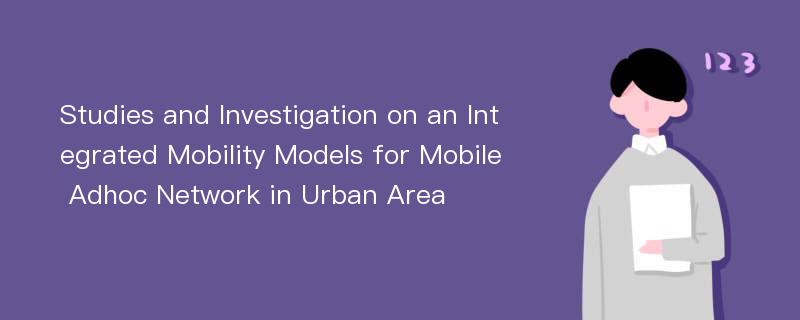
论文摘要
Wireless networks are increasing in popularity due to the current advances in technology. Wireless networks allow users the freedom to travel from one location to another without interruption of their computing services. However, wireless networks require the existence of a wired base station in order for the wireless user to send/receive messages. Mobile Ad hoc networks, a subset of wireless networks, allow the formation of a wireless network without the need for a base station. MANETs are constituted by mobile devices equipped with short rang radio. Communication is possible between devices within each other’s radio range. The mobility lead to frequent topology changes in such networks, which harden typical networking tasksIn order to conduct meaningful performance analysis in the context of Mobile Ad Hoc Networks (MANET), it is essential that the underlying mobility model on which the simulation is based on reects realistic mobility behavior. Mobility clearly is an integral issue in mobile wireless networks. However, little research has focused on realistic mobility. Unrealistic mobility models, such as using random models alone, may result in incorrect conclusions regarding the performance evaluation of mobile wireless network protocols.This thesis introduces a combined mobility model (Random Waypoint with Manhattan and Group with manhattan) that attempt to generate realistic mobility for mobile wireless network simulation in an urban area environment. We consider a typical urban scenario for Mobile Ad hoc NETwork (MANET) deployment. Urban scenarios differ profoundly from open space scenarios, which so far have been the main object of study in MANET research. Moreover, they are of great interest for actual MANET deployment in the real-world. We study the main characteristics of urban scenarios in terms of routing protocols, radio propagation, node connectivity, node mobility and traffic patterns. Their impact on the overall network performance is investigated through simulation experiments based on a synthetic modeling of the most important aspects of an urban scenario. The experimental results point out the difficulties of urban environments with respect to the open space case and show the effect of using in such scenarios.The evaluation of a MANET in urban area environment is under different metrics with the absence of wireless infrastructure and with presence wireless infrastructure in the communication environment. Simulation results are presented using routing protocols (DSDV, and AODV), two previously published MANET routing algorithms, mobility metrics, connectivity metrics and most popular radio propagation models, which have complementary characteristics, have been used to assess the performance. These results illustrate that mobility model changes have a significant impact on their performance.The results underscore the importance of using realistic mobility scenarios in MANET simulation and demonstrate the efficiency of using an integrated mobility model in urban area scenario. It is hoped that this work will greatly increase the fidelity of mobile wireless network performance evaluation. Further, it is hoped that this work also is usher in a new investigation of urban mobile wireless networks.
论文目录
相关论文文献
- [1].Can You Figure Cut the Meanings of New Words?[J]. 疯狂英语(双语世界) 2019(03)
- [2].SWIMMING AGAINST THE TIDE[J]. Beijing Review 2017(30)
- [3].Five: The Figure to Decod China's Future[J]. China Today 2017(08)
- [4].学英语(英文)[J]. 中学生数学 2017(14)
- [5].What Time Is Now?[J]. 新高考(高三英语) 2012(01)
- [6].Basketball Maze[J]. 英语大王 2011(06)
- [7].Simplifying Fractions[J]. 中学生数学 2020(22)
- [8].Erratum to Simultaneous inhibition of PI3Kα and CDK4/6synergistically suppresses KRAS-mutated non-small cell lung cancer[J]. Cancer Biology & Medicine 2019(04)
- [9].WHEN am I ever going to use this?[J]. 中学生数学 2020(06)
- [10].News Roundup[J]. ChinAfrica 2019(12)
- [11].Cover Figure[J]. Neural Regeneration Research 2011(10)
- [12].Cover Figure[J]. Neural Regeneration Research 2011(01)
- [13].Cover Figure[J]. Neural Regeneration Research 2011(17)
- [14].Cover Figure[J]. Neural Regeneration Research 2011(21)
- [15].Cover Figure[J]. Neural Regeneration Research 2011(27)
- [16].Cover Figure[J]. Neural Regeneration Research 2011(25)
- [17].Meeting Elderly Needs[J]. Beijing Review 2020(35)
- [18].日积月累[J]. 新东方英语(中学生) 2014(12)
- [19].Analysis of Chinese/English Codeswitching on Network Language by Figure/ground Theory[J]. 中国校外教育 2011(12)
- [20].抽屉里的秘密(英文)[J]. 英语画刊(高级版) 2014(11)
- [21].Interpreting Foregrounding with the Figure/Ground Theory with a Case Study[J]. 校园英语 2017(36)
- [22].Design method for freeform reflective-imaging systems with low surface-figure-error sensitivity[J]. Chinese Optics Letters 2019(09)
- [23].Restoring the Past[J]. Beijing Review 2018(45)
- [24].Cover Figure[J]. Neural Regeneration Research 2011(23)
- [25].Correction to:Projection from the Anterior Cingulate Cortex to the Lateral Part of Mediodorsal Thalamus Modulates Vicarious Freezing Behavior[J]. Neuroscience Bulletin 2020(09)
- [26].Phenanthrene derivatives combined charge transport properties and strong solid-state emission[J]. Science China(Chemistry) 2019(07)
- [27].Handsome Couple[J]. Beijing Review 2010(10)
- [28].Erratum to spindle cell carcinoma of the breast as complex cystic lesion:a case report[J]. Cancer Biology & Medicine 2014(03)
- [29].Instructions for TUMOR International Authors[J]. 肿瘤 2012(02)
- [30].Fluence rate linear response limit of a scintillators to γ-rays[J]. 中国物理C 2011(07)
